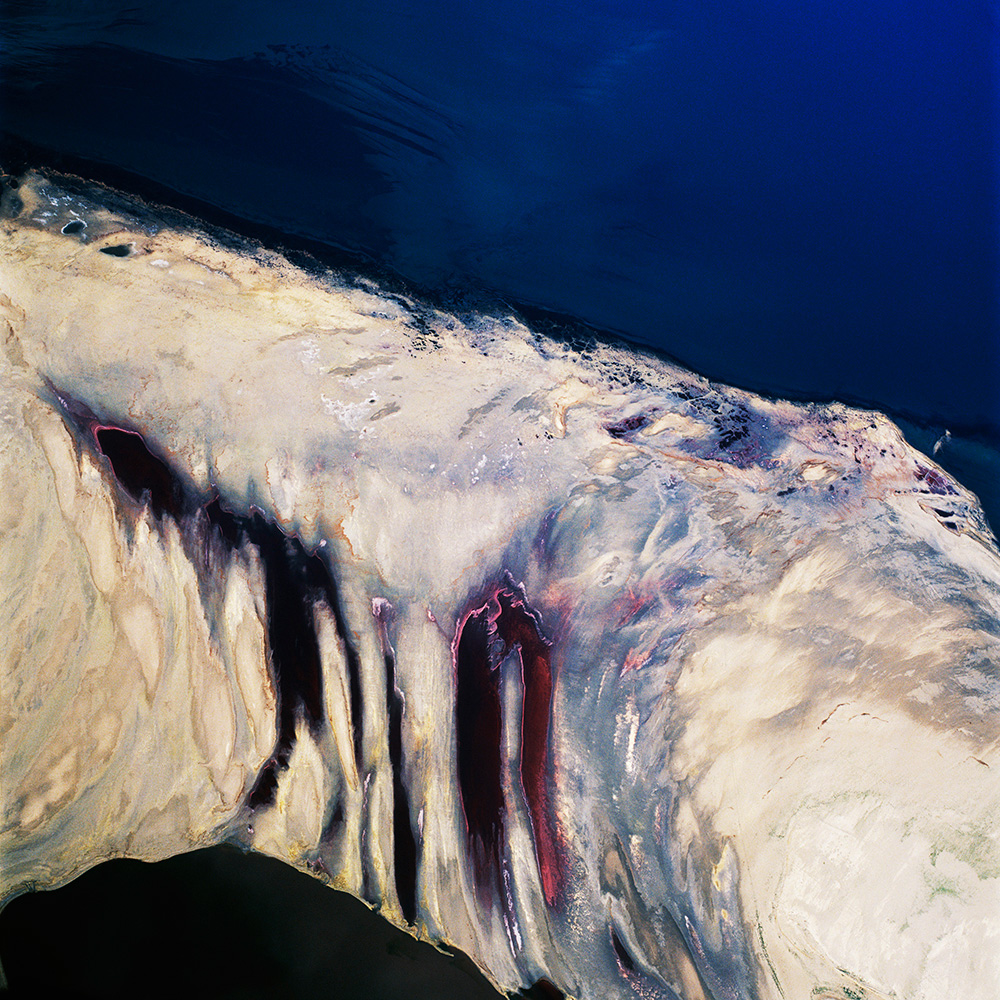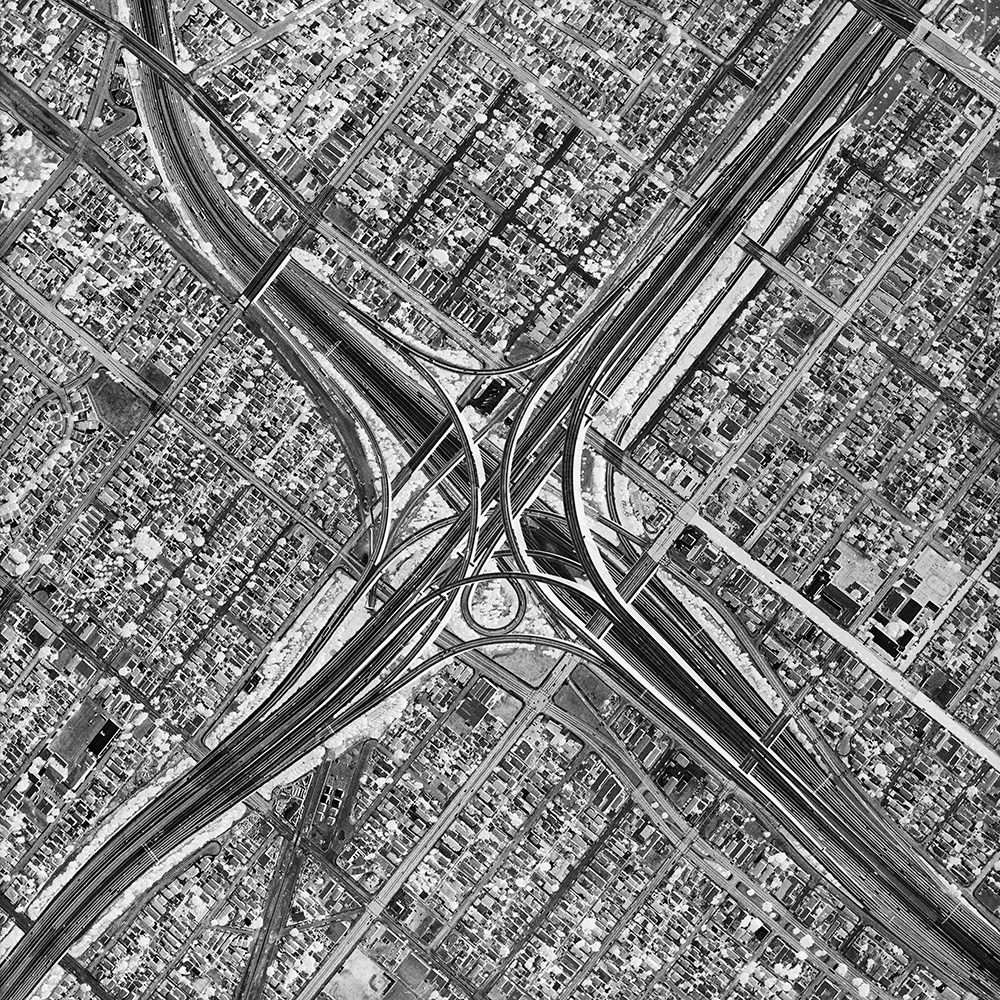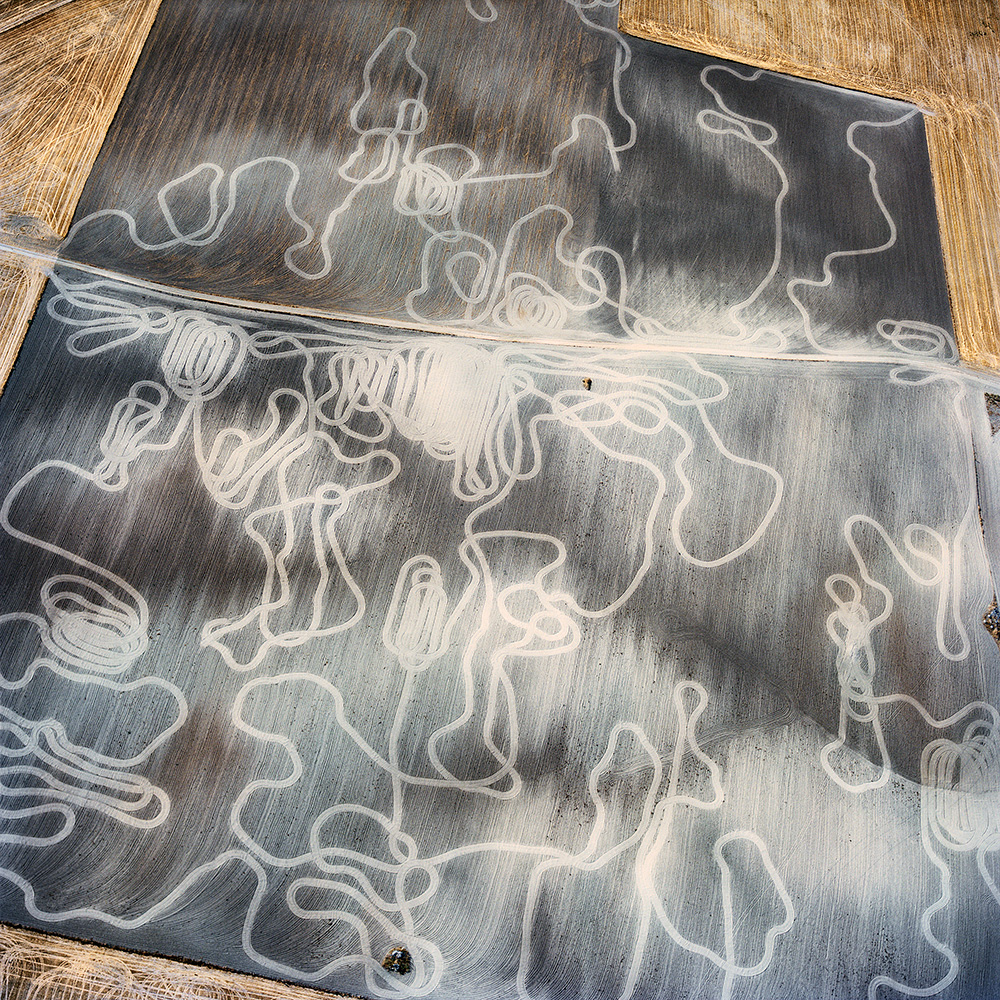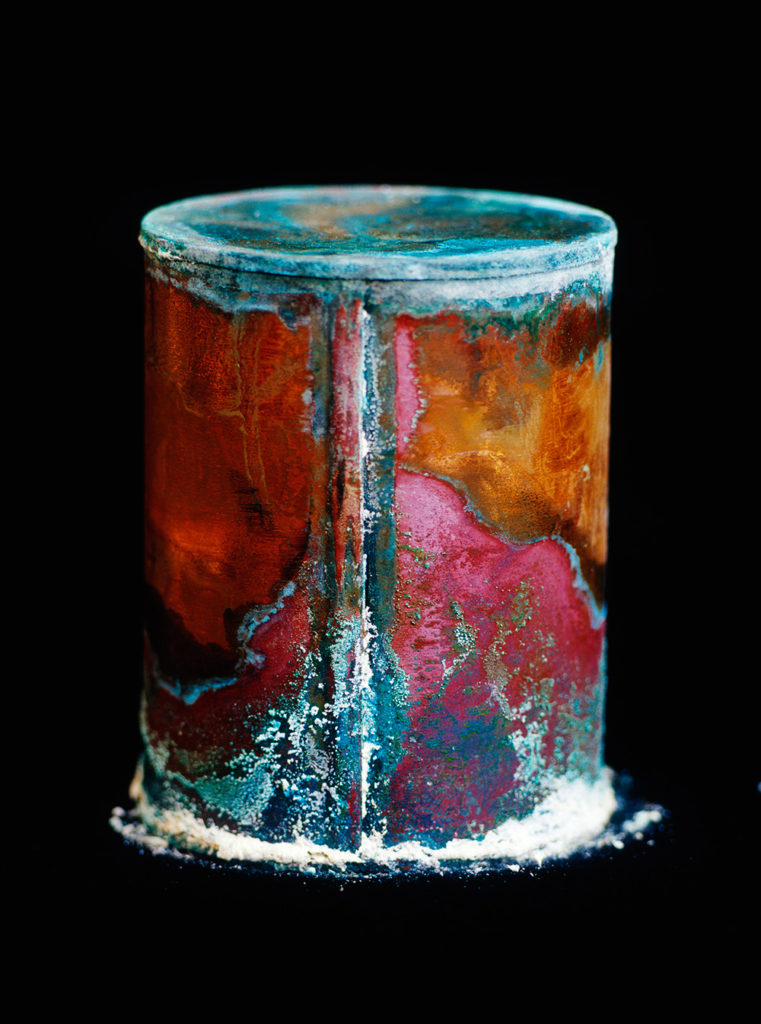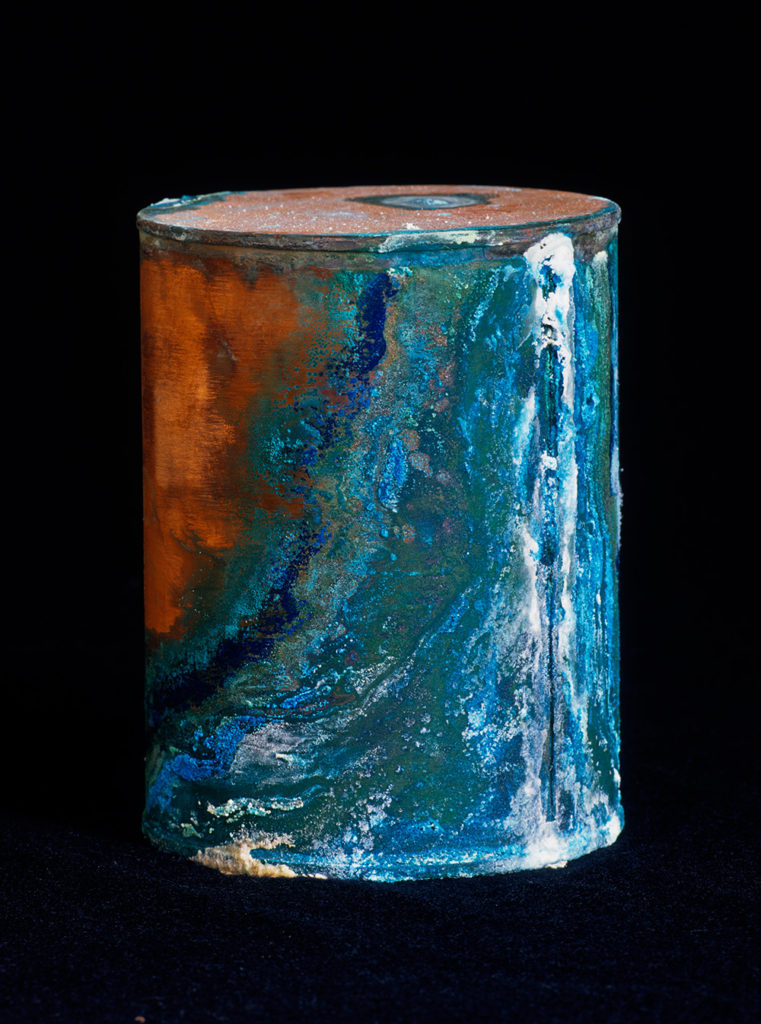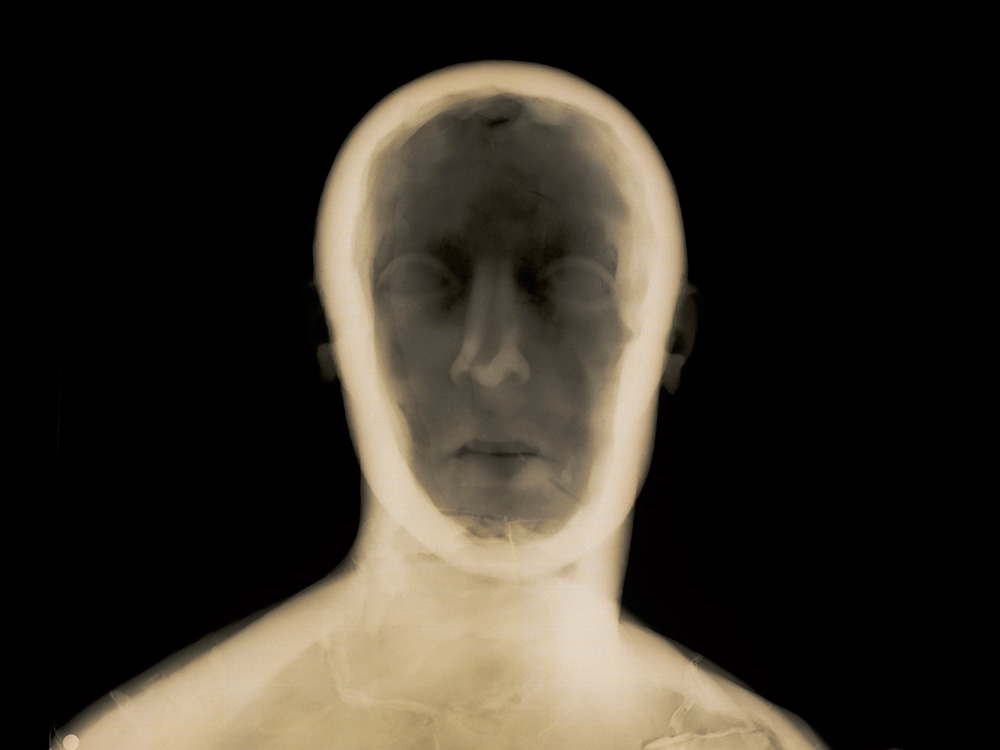David Maisel
The term ‘landscape photography’ might conjure images of pleasant pastures giving way to graceful hills, maybe a line of jagged mountains closing off the frame in the distance — giving form to the theatricality of nature. Or maybe it suggests something more banal, calendar art of fields of daisies, or sunsets at the beach. Rarely do we think of landscape imagery as a site for revealing complex political and cultural forces. Many 19th century photographs of the American West were commissioned by the government, as part of surveying and mapping efforts in preparation for westward expansion. Those photographs of dramatic landscapes were not made simply for contemplative enjoyment — they consciously depicted a virgin territory, an unpopulated, unsullied and promised land — an invitation. We know what came next.
David Maisel is often described as a landscape photographer, although that term hardly begins to describe the breadth and ambition of his project. He is a prolific aerial photographer who has hovered and buzzed over some of the most contentious territories in the American West and in doing so has been instrumental in redefining the terms of landscape imagery. Many of his pictures convey a terrible beauty — to savor their grandeur we must also imbibe a hint of poison. And when not in the air, he has created haunting and ghostly imagery from X-rays and tins of the cremated remains of psychiatric patients. Born in New York in 1961 and now a long-time resident of Northern California, Maisel’s work has been exhibited and collected by many major museums in the world.
This interview was conducted via Skype on June 1, 2017.
MAD: You studied architecture at Princeton. Can you tell me about how you became interested in landscape photography?
DM: I was studying architecture and landscape architecture. What fascinated me in these two fields was how buildings sit in the landscape, and the boundary between interior and exterior, the human-made and the natural environment. So it wasn’t a great leap for me to see that kind of slip into working in photography. I stumbled into a photography class taught by Emmet Gowin. And that was an introduction to thinking about how landscape could be represented photographically. My interest in architecture drew me at first toward exacting, meticulous work in photography, such as that by Frederick Sommer, Lewis Baltz, and Nick Nixon.
I went back and forth between the fields of architecture and photography all through my twenties. I went to graduate school for architecture in my late twenties, and at the same time I had been accepted into some great MFA programs, so I was really—I don’t know if divided is the right word—but conflicted. I really couldn’t separate the two; that was a difficult one for me. The two endeavors really come from the same place, the same interests.
MAD: Architecture is a serious field of study, rigorous and disciplined. I think photography can be as well, but not always. Was there something about Emmet Gowin’s classes for instance, that challenged you intellectually?
DM: Emmet continuously brought his diverse interests and curiosity into the classroom to share with his students. One week he might install a group of original Eugene Meatyard prints in the hallway leading to the darkroom, and the next week he might bring in a book on the Dutch printmaker Hercules Seghers.
The way you study and practice visual art when you’re an undergrad at Princeton is through the Art History department. I had the opportunity to work with the art historians Peter Bunnel, Sam Hunter, and Thomas Crow. I also got to study photography with Emmet and with Edward Ranney, among others. There are really spectacular teachers, art historians and thinkers, and I got to spend time in the Marquand Library, the art history library, and so there was definitely a kind of intellectual rigor expected of students in that program. After switching my focus from architecture to visual art as an undergrad, I stayed at Princeton instead of transferring to art school because I felt I needed that–I wanted that– academic superstructure around how to think about art.
MAD: And at some point you took a trip to Mount St. Helens with Emmet Gowin?
DM: Emmet had taken another photography student with him to St. Helens a year or two before. As Emmet was getting ready to go again I kind of volunteered myself. I said, “Hey, if you need some company I’m available.” It was a spectacular and transformative experience, and tremendously generous of Emmet to include me. Having that material to work with was a gift. I’m actually working on a book now based on the Mount St. Helens work, after all these years. It will be published by Ivorypress later this year, as part of their LiberArs series.
MAD: When did you move to the West coast, and why? Did you discover a special bond between the San Francisco Bay Area and photography and was that significant to you?
DM: My wife Lynn and I moved to just outside San Francisco in January of 1993. We were struggling to find a place that could accommodate both of our inclinations. She wanted to live in a rural environment and I was drawn toward an urban environment. At that point I was getting burned out on New York, and the Bay Area had always been intriguing to me. I viewed it then as an experiment, you know, like New York will still be here if I want to come back. I still feel that way. New York will still be there. But I found that living in the West suited me better in terms of being able to focus on my work. Yes, there is a really deep history of appreciation for photography and even for landscape photography in particular here, but that wasn’t why I moved here. It had more to do with living in an environment where you could have culture, and everything that an urban environment offered, but you could also have the natural world. The real estate gods took mercy on us – we found a tiny little house to rent out in Muir Beach that was perched above the Pacific Ocean. And so it was this rebirth of how you see, and how light affects you, even on a cellular level, to be able to wake up and to look 30 miles out to the ocean.
MAD: Your first major photographic project of yours from the mid-80s is titled Black Maps.
DM: Yes. That title came a few years into working on this series, when I realized it could become a multi-chaptered project unfolding over years or decades. At first I was making aerial images of open pit mines throughout the Rocky Mountain region. And then I was living in Maine, and I started looking at clear-cutting in the northern part of the state. I could see that they were interlaced as projects — they spoke to each other but were also independent. The Black Maps title came from a poem by Mark Strand. When I eventually published the images, Mark gave his blessing to use the title from his poem.
MAD: You have a real affinity towards poetic and literary sources that inform the work emotionally or atmospherically, that anchor the work within or among literary motifs.
DM: Absolutely. You get fed from books and from other peoples’ deep dives that they take for you. As a reader you follow along with their explorations – they take you places you would never think to go.
MAD: When I was living in San Francisco, my first teaching job was a UC / Berkeley Extension – which offered Adult Ed classes nights and weekends. I was teaching black and white photography, and was able to take other classes for free. I attended a weekend workshop with the Polish poet, Czeslaw Milosz, who was a professor at Berkeley. For some inexplicable reason, I have an affinity for Polish literature, and spending a weekend with him in a classroom when I was 28 has fed me for years. It wasn’t anything specific that he said, although he said and read many incredible things. It was his approach to literature and life — that they were, for him, inextricable. He had spent his life dealing with words and images and history, and trying to find a form. And here he was this sort of elderly man at that point, but still trying to find form, that was incredibly inspirational to me.
DM: Yes, these early encounters, things that you maybe stumble into in your twenties, can have a long-lasting ripple effect.
MAD: This was also around the same time that I met Larry Sultan, also hugely influential. So back to you…
DM: Well since you mentioned Larry, I’ll say that eventually I abandoned that architecture graduate program I attended at Harvard, after a year. So it was an experiment that might be considered a failure, although it was actually profoundly useful. Years later I ended up deciding, OK now it’s time to get my MFA. In part that was to have an opportunity to work with Larry. So, I ended up at CCA, but it was a long time coming.
MAD: One of the larger, later projects is called Terminal Mirage, and contains perhaps your most abstract images. When I am looking at them sometimes I cannot identify what I am seeing. I can’t fully grasp what I am looking at. There are clues, they appear to be aerial images, but sometimes they are indeterminate. The title itself suggests that illusion might be deadly. Can you talk a little bit about that project?
DM: Sure. I’ve been interested in Robert Smithson’s work for since my student days. I had read in the early 2000s that the Great Salt Lake was starting to shift back into a drought condition, and after years of being submerged under water the Spiral Jetty was starting to reemerge. I thought that I needed to make a pilgrimage there to look at this evolution. That inspired me to re-read some of Smithson’s essays, particularly ones where he was searching for a site for Spiral Jetty. He writes about the light of the Great Salt Lake and these kinds of mirage-like conditions there. As I started researching the Great Salt Lake I realized there were lots of reasons Smithson chose to work there. For example, it is quite industrialized around its perimeter. That’s what that project became for me, an exploration of these surreal and otherworldly environments — basically a lake that is also a giant mine, surrounded by evaporation ponds that are gorgeously and bizarrely colored. Some of the industry there is quite toxic, some of the worst environmental issues in the United States. I became fascinated with that terrain.
As for the title, I had been working with the curator Robert Sobieszek for quite a while, and he had written the introduction to my first book. He’d also previously written an essay about Lewis Baltz’s landscape photography in the American West that he titled “Terminal Documents,” in which he spoke of the Ballardian ‘terminal desert’, and in which he quoted Baltz as thinking of photography as “a narrow, deep area between the novel and the film.” All of that contributed to my titling of the Terminal Mirage series. And, you are right, there are very few clues as to what you’re looking at — the images are highly abstract, and without scale as much as possible. They intentionally reference mid-century painting – specifically Rothko, Diebenkorn, Frankenthaler and Still.

Left, Honore Daumier, Nadar Elevating Photography to the Height of Art, Lithograph, 1862. Right, William Henry Jackson, Grand Canyon of the Colorado River, 1883.
MAD: I want to ask you about a William Henry Jackson photograph from 1883, I don’t know if you know it, but it shows two men on a rocky outcropping overlooking the Grand Canyon, one figure is reclining, taking in the spectacular view in a contemplative fashion, while the other is standing with a telescope peering into the distance. For me this image is more than just an echo of Casper David Friedrich’s romantic painting of the subjective self-encountering the sublime. This photograph is emblematic of the inextricable duality of landscape, at least in the history of the United States, as aesthetic experience, and landscape as a site of control or domination. This photograph not only represents this duality, is literally an artifact from that history, as Jackson was part of the government survey team exploring and measuring how the Western territories might be exploited. And in some ways your work derives from that moment, your pictures suggest an omnipotent eye, overlooking this vast area – for both esthetic and utilitarian purposes.
DM: Yeah (laughs), I was not looking to repeat the endeavors of the 19th century exploratory photographers like William Henry Jackson, Timothy O’Sullivan, and Carleton Watkins. But I was interested in how they might become a kind of template for me, moving further westward in my own interest and explorations, and eventually living here. Yet those were all government-sponsored surveys, and that’s a significant difference. I can take a much more critical view. There was a kind of grandeur and maybe a sort of acceptance of the West as something to be settled, to be exploited, as you said. The landscape was not a site of control; it was actually a site of a lack of control. We as a society endeavored to exert control, because it was outside of our domain. We wanted to tame the wilderness, subvert it and subsume it. The whole point of those exploratory surveys was to see what we could dominate. They believed it was God-given. It’s a pretty limited view and has not been sustainable. That is not how we think of the landscape anymore. Now we might think of the landscape– “lets go to the beach” or “lets go to the shopping mall,” or maybe “let’s go to a national park,” but then it’s already this kind of protected domain—it’s framed for our pleasure and our use.
MAD: Nature as a theme park.
DM: Right. What I’ve been looking to do is sort of pull back the curtain on these “other” kinds of spaces that are not generally visible. The American West as it is never intended to be seen.
MAD: While your images inevitably raise the issue of environmental destruction, you’ve stated that your pictures are not activist works, per se. Ideally, how would you like your photographs to function in relationship to ecological issues?
DM: Obliquely. (Laughter) They should function obliquely. In other words, I really don’t want the work to be didactic. For me that’s the death of the work of art — when it is attempting to tell you what to think, or it somehow answers the question for you. These issues of landscape and land use and abuse are complex, and in a way photography is ill suited for that kind of endeavor. When I was younger working on the first black and white mining work, I was titling the work very specifically, like ‘Cyanide Leaching Fields, Open Pit Copper Mine, Ray, Arizona.’ There can be merit in that specificity, but what I saw when the work was exhibited was viewers reading the wall text, glancing at the image and moving on to read the wall label for the next photograph. The titles were helping them jump over any problems that might actually be in the work itself. They were interrupting any kind of visual complexity or conundrum of meaning the art might contain. That’s when I shifted to titling my projects more obliquely. During lectures, however, in contrast to exhibitions, I often speak in great detail on the environmental issues in each project, and sometimes in each image. And in my books, I always include essays and support material that’s text based. But in exhibition form I prefer to pull back, to limit that textual information, and to allow the visual experience to be the driving force.
MAD: The primary experience.
DM: I could walk around my studio and take pictures of this beautiful stained cement floor all day (laughs) and it would look like some of my landscapes. The sites themselves are critical, but I’m not asking for some kind of direct action, like OK now that we see what open pit mining looks like, we should stop it. That’s not realistic. Should mining practices be cleaner, and should the legislation that governs mining practices be updated from the 1872 mining laws? Yes, undoubtedly.
I think that if the pictures engender dialogue and more heightened awareness, that’s good. But I’ve also feel these pictures are psychic landscapes in a way. In other words, they are also portraits of the society that made these places. So yes, they’re topographic, but there’s also something else going on, and that’s where the power of abstraction comes in. The images are not really thoroughly descriptive of these places; they’re very fragmented and highly abstract.
MAD: Writers and critics often compare your photographs to the paintings of Paul Klee, Mondrian, Sol Lewitt, Mark Rothko, Agnes Martin, just to name a few. Is this a coincidence, an example of how something always looks like something else, is it just a function of aerial imagery that it inevitably flattens landscape, making it resemble two dimensional images, are you responding photographically to that specific art history? Or is there something more mysterious going on, that for some reason human culture transforms the landscape in ways that are similar to the ways that artists transform a blank canvas?
DM: I think that my background in art history and my interest in mid-20th century abstraction have filtered into the work, for sure. What you said about the aerial view tending to flatten space is also true. There’s also something in the presentation of the work and the scale of the prints that contributes to that as well.
MAD: I’m wondering if there might be a connection between how the land is inscribed, used and abused to the way individual artists might represent certain psychological spaces in their work.
DM: Well, when I started looking at mines — there was something really dark about those spaces. And I don’t mean dark in terms of tonal range; I mean they were these kind of eviscerated holes in the ground. On some very primal level there’s a kind of horror intrinsic in those kinds of places. I wanted to find subject matter that reflected something that I was feeling internally. So it was never entirely, exclusively about environmental issues. I have to have some kind of personal or internal reason — I have to be drawn to the material in a way that is not rational, and might, in fact, be irrational. It’s very hard for me just to go out and document a site because it’s problematic environmentally. There’s got to be more —it has to be visually compelling to me, but then there’s also some other aspect that pulls me in.
Let me give you an example. I have worked at Owen’s Lake, the subject of my series The Lake Project, for fifteen years. It occupies a pivotal position in the history of water in the West and in California. But there’s something else there beyond the story of this site’s environmental demise. A viewer at an exhibition of The Lake Project introduced himself to me; he told me he was a cardiac surgeon, and that my photographs of Owens Lake reminded him of what he sees in the OR when operating on human beings’ hearts. My mother had passed away during heart surgery several years before I started working at Owen’s Lake, and I had made this unconscious association between the landscape of Owens Lake and her body during surgery — the trauma of the landscape as being akin to the trauma of the human body. By the time I had this conversation with this surgeon, I had realized that The Lake Project was also, in part, a way for me to process my grief over her death. Viewing that landscape again and again, from every altitude and angle, was a way of mourning.
MAD: I think it’s that personal thing or internal thing that motivates us, that redeems the work from didacticism. We make art to experience things, to know things obliquely. To experience something doesn’t mean we can necessarily name it. It’s this kind of oblique knowing in sensory, psychological or spiritual ways that compels the artist.
DM: Definitely. There’s a book by Wallace Stevens called The Necessary Angel: Essays on Reality and the Imagination. I use a quote from it sometimes at the beginning of lectures: “We live in the center of a physical poetry, a geography that would be intolerable, except for the non-geography that exists there. Few people realize that they are looking at the world of their own thoughts and their own feelings.” That’s the kind of correspondence I am referring to.
MAD: I want to ask you about the Oblivion series. Which is a series of aerial images of Los Angeles, or the Los Angeles basin I guess. So many of these photos are without horizon lines, as many of your pictures are, transforming the landscape into an abstract grid. The images in this series are black and white, and they are printed in negative. I’m just curious about those decisions, about the black and white and then printing in negative.
DM: Those decisions came separately. I was drawn to working there in black and white — I wanted every element to feel of a part of everything else around it. It seemed the way to best express that is by working in black and white, where everything is reduced to tonal range. I also wanted to work with faster speed film than I normally might, because I wanted there to be a kind of photographic grain that suggested the city was made of ash. I started making prints from that series, and wasn’t entirely happy with them — they felt too familiar, somehow, even though the aerial view wasn’t quite as normative back in 2004 as it has become now with Google Earth. And then, when I was viewing my negatives on a light table, I saw an image that was ghostly, spectral, mysterious, and a little scary, and I thought OK, this seems to hold the kind of de-familiarization that I need, so let me try printing these pictures in negative.
MAD: I was thinking about that satiric Daumier cartoon of Nadar hovering in a balloon over the rooftops of Paris. Nadar is drawn with his camera pointed down at the city and all one can see are signs for Daguerreotype studios. Even then, so early in the history of photography, there were jokes about the redundancy of photography, the Meta aspect of making a picture about making pictures. I think of that when I think of you hovering over Los Angeles making photographs of the land of pictures.
DM: Yeah totally, absolutely. It is a city made to produce pictures.
MAD: I was thinking about the term — California noir. From Day of the Locust to Terminator and Blade Runner, that despite the glitz and endless sunshine, LA is often the site for metaphors of darkness, for the cinematic and literary post-apocalyptic. Did you feel or did you ever sense a danger of over-playing the motif of LA as a symbol of the apocalyptic sublime?
DM: To me it had more to do with a moment in time. For example, there is nothing in the title that indicates that this is Los Angeles, right? And of course it is, but it’s not referenced anywhere, so LA becomes a stand-in for any number of possible places. It’s the contemporary condition, in a way. But for me it was more about a post-9/11 space, the idea that apocalypse is possible and the destruction of the urban environment is possible. But yeah, there’s a whole film noir history based around the idea of Los Angeles, as well as the strange ways that day-for-night filming feels, and all of that is being alluded to in Oblivion.
MAD: Your photographs are primarily sites in the U.S. that have very complex histories and realities. A few years ago you did a project in Spain. Obviously the history of that landscape is quite different from your usual subjects. How did you prepare for that? Was that more of a formal exercise?
DM: That’s a good question. I was invited by Ivorypress (the gallery I work with in Madrid) and the city of Toledo to participate in an exhibit to mark the 500th anniversary of El Greco’s death. There were about a dozen artists involved, among them Vic Muniz, Abelardo Morell, and Philip-Lorca diCorcia. I was invited to make aerial photographs of Toledo, and it was really interesting. It reminded me of ways I was thinking about architecture when I was a lot younger, in particular the book Architecture without Architects by Bernard Rudofsky, which spoke about architecture as a kind of communal effort. I began thinking about the difference between Toledo, the former cultural capital of Spain, and Madrid, the current cultural capital. So I started researching the spaces between these two places, and that became the parameters for my work there. Vicalvaro, for example, is an enormous urban development on the periphery of Madrid that ground to a halt after the economic collapse; it is basically eroding back into the ground and so it looks like an archaeological site of an abandoned civilization.
Other areas that I worked in had more to do with the way mining and agriculture are kind of interlaced there. The agricultural zones look completely unlike anything you would find in the United States, because the way these fields are divided up goes back centuries, and so it’s literally much more organic in form. There wasn’t a specific environmental disaster or backstory to these sites that I was responding to, and I was putting the pleasures of abstraction into the foreground.
MAD: Those pictures are just so lovely. But also its really fascinating to look at a landscape that is foreign, to my eyes, at least, the way the land is contoured, how fields are divided up in more organic shapes instead of the grid that we see in the United States. One can observe the way that the way humans carved roads and tended fields, and how those cultural gestures interact with the rivers, erosion, rises and dips in the landscape to create this kind of extraordinary organic composition. In many of the pictures one can see an alkaline layer on the ground because this land was once a sea and when it’s plowed the alkaline is brought to the surface, and it shimmers like a light frosting.
DM: It’s really fascinating. Actually, that’s what drew me to that area, it’s quite surreal. The soil has a feeling like graphite, it has this kind of shimmer to it, it is absolutely lovely (laughs), mesmerizing.
MAD: This is an off-the-wall question: do you ever photograph people?
DM: (Laughter) Oh god. I did. I mean I have. But no, I don’t generally photograph people. When I was an undergrad I did a project where I was photographing my friends and social circle; we were basically doing nudes in the landscape with a 4×5. It was about the process of revealing oneself, physically and psychologically. I shifted from photographing individuals to photographing couples (laughs) and at one point I was photographing a couple in my studio and they started fucking, and I thought, you know what, I’m out! (Laughs). While I don’t photograph people, I am a people watcher. I am fascinated by what people look like. But I never quite developed the skill or the vein of really working with people. I photographed my daughter a lot when she was younger and then I stopped, because I didn’t want her to grow up feeling as though she had to perform for her father or for the camera.
MAD: I was thinking about the Library of Dust as kind of your portrait project.
DM: I was going to say that, that’s true. Yes — alchemical portraits.
MAD: Can you describe how you came to know about that site?
DM: Sure. I was at a cocktail party (laughs) in 2005, talking to a journalist who was an editor for Time magazine, and I admitted to him that I hadn’t read Time in years. And he said that he didn’t read magazines at all, which was rather stunning. I asked him where he got his news, and he said he read blogs. I asked him what his favorite blog was and he said it was BoingBoing.net. I wrote it down on a scrap of paper and put it in my wallet. Eventually I went to the BoingBoing site, and on that particular day it had a post about these canisters of cremains from the psychiatric hospital. I immediately knew I wanted to photograph them, for a number of reasons. The primary one was that they were copper, and I had been looking at copper mines for so long. I was just really fascinated with the materiality of copper.
I wrote to the superintendent of the hospital to request permission to visit there and to photograph the canisters. I anticipated that he would turn me down, but apparently he knew of my work, and he wanted to support the notion that these objects deserved to be seen. He wanted to help remove any mantle of shame around them and around psychiatric illness in general, and so he said yes, and supported my working there even when others in the hospital administration opposed the idea. The objects were mysterious and compelling and just fantastic and alive. The kind of physical and metaphysical energy in that room where they were stored was profound.
As I mentioned, my mother had passed away suddenly. And several years later, with the events of 9/11, one of the things that clearly compounded families’ suffering was that there was frequently no body to recover. So the question of what happens to our bodies when we die, and where does the soul live if the body is gone— these kinds of existential questions were on my mind, and Library of Dust became a way to consider them.
Many of the patients whose cremated remains were housed in these canisters had been written out of their family histories. On a similar note, I had recently learned that late in life, a few years before I was born, my grandfather had suffered from such debilitating depression that he actually had twelve rounds of electro-shock therapy (the last one finally doing the trick, and enabling him to return to his normal state of being). That history, that story, had almost vanished within the span of one generation in my own family. So these kinds of gaps in families and in their histories was something I felt personally, and the hospital holding these thousands of canisters was rich with these untold stories. I became obsessed, there was so much to uncover.
MAD: I just want to make a couple observations about Library of Dust. There are so many remarkable things about that place and those objects in your photographs that I hardly know where to begin. That the containers are constructed out of copper is resonant, they appear to be handmade, so that each container feels like an individual. That copper is an effective conductor of energy is significant of course; that the first photographs of daguerreotypes were made of copper is a lovely confluence. The eruptions of color on the surface are a result of many environmental factors but also a function of the human remains inside the containers. Those encrustations look a lot like your landscape images in miniature.
DM: There’s a very strange synchronicity there, for sure.
MAD: But so unexpected. In one of your essays in the book it you describe the canister as clock registering time on its surface. This is a way of thinking about the photograph as well. Not just the temporal anchoring of the shutter’s release but that photographs, as objects, take on traces of time. A scratched tintype or faded and creased color snapshot from the 1960s bear witness to their passage in time. And this is a kind of aside but those canisters remind me of Boltanski’s tin boxes.
DM: Yes.
MAD: Although your canisters are not merely symbolic like his are, they are actual vessels containing the remnants of life and death. Your photographs in Library of Dust are oblique records of the history of how we treat or don’t treat mental illness. All sorts of stories are suggested by the canisters themselves and also about the institution that preserved them. Do you know Maude Casey’s novel The Man Who Walked Away?
DM: No.
MAD: I think you might like it. It’s apparently based on a real person, a patient in a 19th century French asylum, who had an obsession with walking; he keeps walking away from the institution. All sorts of things are blended into the story, like the history of photography, attempts to visualize and categorize madness. It also envisions a more compassionate treatment for those who suffered from mental illness.
DM: I will definitely look for it. When this hospital in Oregon was built in the 1880s, it was a state of the art facility. The rooms were very tall, with a lot of windows providing natural light. The grounds of the hospital were a campus-like setting; like an arboretum, with specimen trees. It was truly a campus. I’m not saying there weren’t misdeeds but it was also an asylum in the best sense of the word. It was a place of refuge for people who were unmoored from society for various reasons.
The project also developed in ways that weren’t photographic, per se. I’ve received a handful of letters from people who have reclaimed their ancestors because of this project. Another remarkable outgrowth of this project was that the governor or Oregon, with my permission, used my photographs of the canisters to argue on the state senate floor for funding to rebuild the hospital. Oregon has now devoted some $450 million to modernizing and rebuilding the Oregon State Hospital. Due to that state funding, the Oregon Council on the Arts was able to hold a competition for the design of a memorial structure to house the canisters. The design was awarded to Lead Pencil Studios, the structure is now completed, and the canisters have an appropriate home.
MAD: I want to ask you about your project you conceived during a residency at the Getty — History’s Shadow. The images are x-rays of objects in the museum’s collection.
DM: Right. I began my residency there thinking that I might try to do a project on microscopy of paintings. To connect my mining photographs and the Library of Dust canisters, I was thinking about the pigments of paintings as minerals. I was spending time in the painting conservation lab, photographing the conservators at work. It was really interesting, watching how you clean a 12th century altarpiece with a Q-tip and your own spit (laughs). One day I walked in and there was a 10ft-long x-ray taped up to the window, backlit by daylight. It looked like an incredible Franz Kline drawing, very expressionistic. On the easel next to it was the 19th century landscape painting by Daubigny from which it was derived, and which was fairly uninteresting by comparison. I discovered that the Getty x-rayed many of the objects in their collection; again this was another example of a spark being ignited in response to objects being hidden away in an archive that was not intended to be seen by most people.
MAD: The objects in the museum are already displaced from their original context by time, and by acquisition. You decontextualize them further by using the x-rays, which collapses the interior and the exterior duality. We don’t know their size, their materiality, or their origin. We meet them, so to speak as individuals. For example, there’s an image of a Greek sculpture of a man created, I’m just guessing 2500 years ago, yet in your rendition, he seems fully present, if somewhat ghostly, as if he is an individual, as if I am looking into the eyes of the Greek person from more than two millennia ago. And even though the image is not a conventional photograph, it retains photography’s indexicality, suggesting that I am looking at a specific person in a specific moment. The image feels like a living portrait.
DM: Exactly. In fact the image that you are describing of that man was the first x-ray that I saw where, after looking at many hundreds of x-rays, I felt, there’s something exceptional here. It offered that spark of recognition. The connection was immediate and intense. It was as though he was looking right at me and right into me from centuries ago. I don’t think I had ever deeply understood until then that artwork from antiquity wasn’t always old; there was a point at which it was contemporary. The contemporary is constant but its also constantly shifting. The x-ray somehow reanimates those works of art from antiquity, it comes alive in a way that maybe the artwork itself might not be able to at this point in time.
MAD: The last thing I want to ask you about is about the most recent work, Proving Ground, for which you photographed a highly secretive weapons testing area in Utah. I was amazed to find out how big that area is — it’s larger than the state of Rhode Island.
DM: Yes. More than 800,000 acres.
MAD: And you chose to make two bodies of photographic work — large prints mounted on aluminum, and hung in grids, which is a very contemporary way to display the work, but you also chose to make albumen prints, which is essentially a photographic technology that died in the 19th century. Can you talk a little bit about the decision to have those two manifestations?
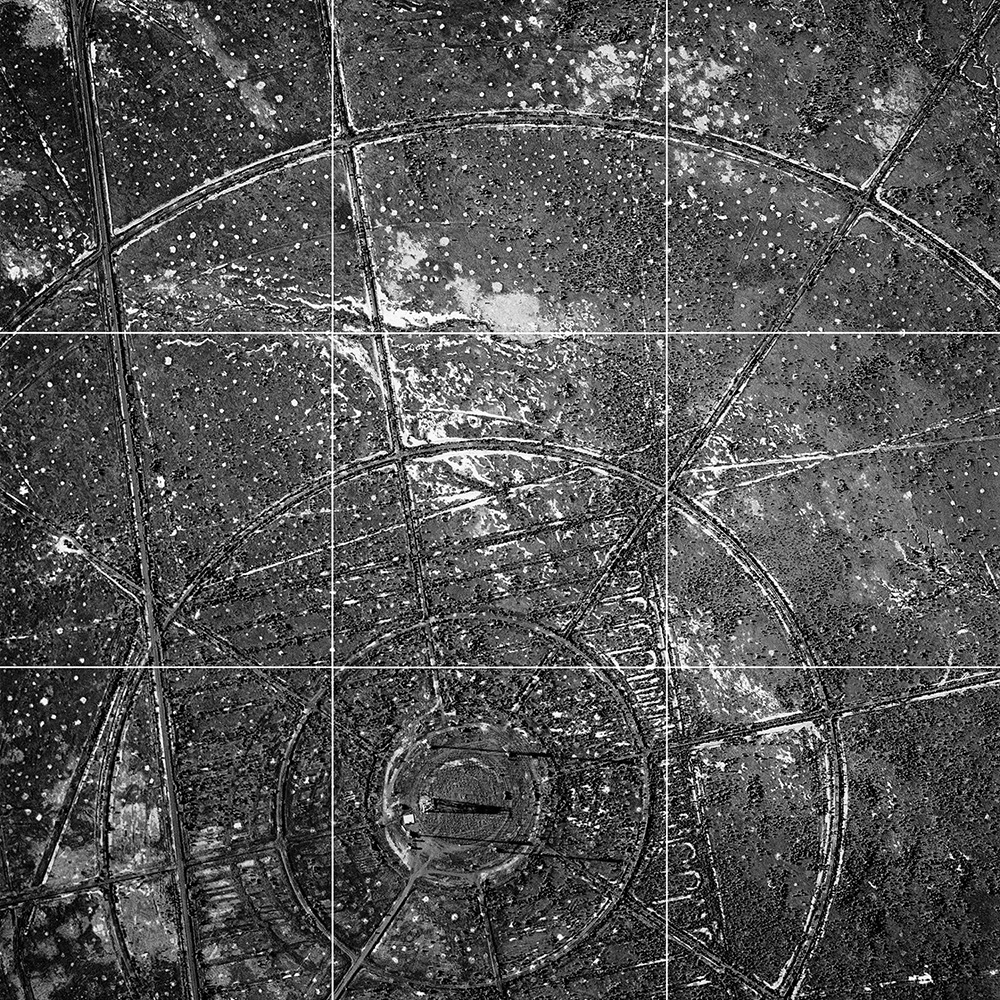
David Maisel, Proving Ground, South Ballistics Grid_04, 2016. Dye sublimation prints on aluminum. Nine panels at 40×40″ each. Overall dimensions approximately 128×128″ (variable)
DM: Sure. The large prints of the grids are actually printed directly onto aluminum, so you actually read the metal through them. Each element of the grid is printed at 40×40 inches, so the entire grid ultimately becomes more than 10ft square. That was where I first went with the work, thinking about the limits of the cartographic aspect of photography. We expect photographs to render some kind of truth but they’re actually very hard to read, and embody the kind of difference between subjective looking and objective data. I was also interested in putting a grid over spaces that are themselves already gridded, these sites for testing chemical and biological threats inscribed by the military onto the desert floor, sites where toxins are detonated and their dispersal patterns measured across time and space.
The albumen prints came about because I wanted to think about where 19th century exploratory photography fits into this history of remaking the American West — the origins of that. I had the opportunity to collaborate with a print maker, Barret Oliver, who is an expert in 19th century processes. We considered various possibilities, and albumen seemed to be the method that would offer the richest way to explore these ideas. The albumen prints are not over-gridded by me as the aluminum prints are, so they picture a unified space. In addition, they are printed at a relatively small scale – 12 by 12 inches, almost like book scale, and much more intimate. I had a notion that these spaces might someday become archaeological sites with which a future civilization could look back at us, and try to decipher what we’d been. By using a 19th century process I wanted to suggest the notion of the past and the present and the future kind of all being folded up together.
I’m also nearing completion on Kydoimos: The Din of Battle, a 30-minute projection piece based on some 50,000 aerial images of these gridded test sites, with a score by the composer Chris Kallmyer. And Steidl will publish Proving Ground as a monograph in 2018, with essays by William L. Fox, Tyler Green, Geoff Manaugh, and me. Stay tuned!

David Maisel, Proving Ground, Tower Grid_02, 2016. Dye sublimation prints on aluminum. Nine panels at 40×40″ each. Overall dimensions approximately 128×128″ (variable)
Editor’s Note: Maisel’s Proving Ground will open at Haines Gallery in San Francisco, on January 4, 2018.


